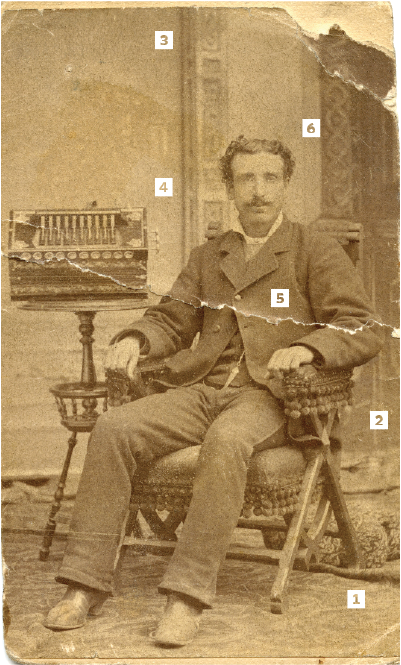Sign up for the Family Tree Newsletter Plus, you’ll receive our 10 Essential Genealogy Research Forms PDF as a special thank you!
Get Your Free Genealogy Forms
"*" indicates required fields

In the early days of photography, professional shutterbugs often used props to give an image context and warmth. Curtains, backdrops, rugs and furniture frequently appear in old family portraits. Painted backdrops also were common in photo studios. By the 1880s, the painted scenes mimicked household interiors and landscapes.
Patrons also brought their own props to pose with, and these items can reveal your ancestor’s occupation, hobby or other personal details. Such is the case with this photo belonging to Alaric DeArment.
DeArment submitted this photograph with the question “What’s the instrument on the table?” His mother—who, as an ethnohistorian, studies cultures and customs—believes the prop in this photo is part of the man’s identity. She’s right.
The back of the photo is labeled “Wm Horn.” Horn, born in 1864 in Utah, according to DeArment, was the older brother of DeArment’s great-great-grandmother. She’s found him in only four decennial censuses: During the 1870 and 1880 enumerations, he lived in Richmond, Utah, with parents Thomas and Sarah Horn. In the 1910 census, he was widowed and again living with his parents. In 1940, Horn resided with his son in Butte, Mont., also home to DeArment’s great-grandparents.
Visual clues help date this photo to the 1880s, but it often takes an antiques expert to identify a mystery prop. According to a curator in the musical instrument department at Boston’s Museum of Fine Arts, the instrument is an accordion. The three stops (the buttons on the right side) alter the voice of the instrument, which is similar to a pipe organ, and probably add harmonious intervals to its music.
This type of small instrument was used to play simple parlor music. The presence of the accordion shows Horn was a musical man who liked to entertain family and friends.
Simple parlor music of the late 1870s could include vocal pieces or instrumentals played in concert with other instruments. You can learn more about the popular music of the era in the Library of Congress’ American Memory collection.
Here are some other key clues that can help us date this photo:
- This studio could use a little housekeeping: The rug is partially rolled up and there’s a cushion on the floor behind the chair.
- Horn sits in a chair trimmed with pompom tassels. It looks like it folds up when not in use. The accordion is prominently displayed on the table next to him.
- It’s difficult to tell if this architectural-style backdrop is wallpaper or a painted scene on canvas.
- The stops on the side of the instrument help identify it as an accordion used for simple parlor music. Unusual props often require an expert consultation. A curator in the musical instrument department at the Museum of Fine Arts in Boston helped identify this accordion.
- In the 1880s, it was common for men to pose for portraits with the top jacket button fastened. This heavy wool coat isn’t the narrow fit typical of that decade, but our ancestors often wore clothing after trends had moved on. Horn’s tie style and wide lapel suggest he bought this outfit in the late 1870s.
- The slightly off-center part of Horn’s greased hair and the way he wears it brushed out from the head was a popular style in the 1870s. Small mustaches and partial beards were common as well.
From the July/August 2013 Family Tree Magazine
ADVERTISEMENT

